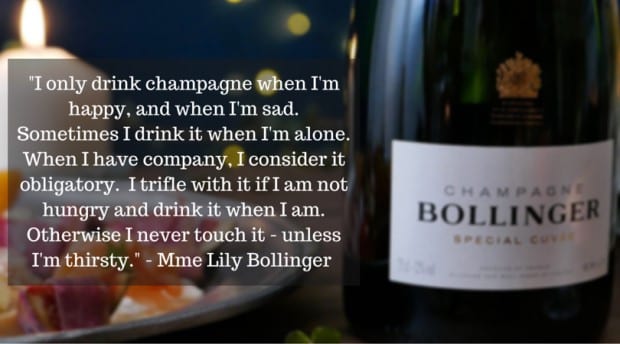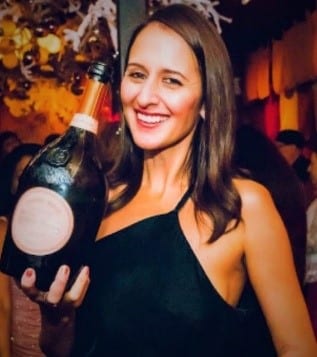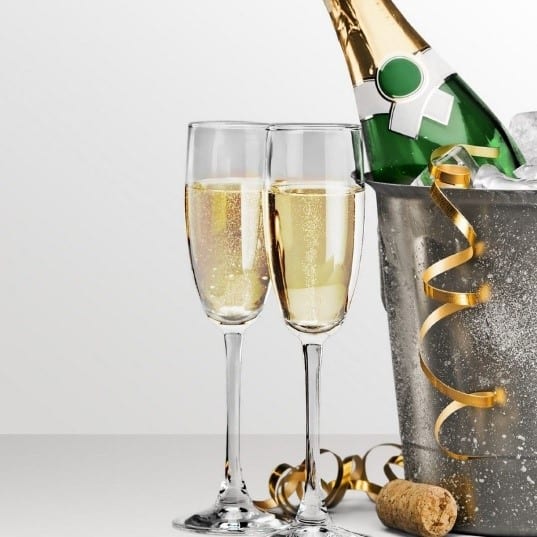The Founder of New York Champagne Week,, Blaine Ashley, was interviewed by Dr. Elinor Garely, where the discussion focused on why Champagne is exactly what the world needs now.
- Can opening a bottle of Champagne help us get through the rough, lumpy, bumpy, uneven road otherwise known as COVID-19?
- More consumers are finding it enjoyable throughout the year on family tables along with a dinner of fried chicken and french fries.
- The end of 2020 saw Washington, DC, retailers selling more champagne after the Biden/Harris win than the previous two New Year’s Eve celebrations combined.
Beginning in early 2020, the world as we knew it, lived it, experienced and frequently – even loved it… has been altered. The alternation has not been rendered by talented fashion designers, artists, musicians, chefs, or architects. The change has been made by former presidents, world government bureaucrats, and corporate executives who, beyond expectations, have been able to ignore science in the belief that politics RULE.
Like autocratic and demi-gods, corporate tyrants, and other misguided leaders before them, history offers a glimpse of hope. While the immediate past and the short-term future looks dim, enlightenment will prevail… if we can live long enough!
So – how do we get through the rough, lumpy, bumpy, uneven road ahead? We open a bottle of Champagne and gaze upon the bubbles with the belief that others have made it through wars and pestilence, bigotry and hate, and we are tough enough and resilient enough to make it through COVID-19.
The Answer is Champagne

Before 2020, Champagne consumption had increased with exports to the US growing by more than 5 million bottles between 2015 and 2019 (Comite Champagne) and Champagne’s market share had increased by 3.51 percent since 2016 (Drizly).
Unfortunately, the grape growers and wine producers in Champagne, France, along with the rest of the world, have been negatively impacted by this pandemic. Beginning in April 2020, the Champagne market dropped by 1/3, equal to approximately $2 billion in revenue and equated to 100 million bottles of Champagne – left in inventory… unsold.
This is not the first time that consumers turned their backs on Champagne. In 2009, there was a 28 percent decline in exports, and during the Great Depression, almost a century ago, Champagne was not the beverage of choice. In other words, the 2020 decline has been incredibly disastrous but not a surprise.
Challenges Facing Champagne

Marketing is Responsible
The problem exists not because of the product but rather by its marketing focus. Champagne is equated with groups of people who are happy, celebrating the beginning of life (a new birth), a new job (or promotion), a wedding or an anniversary, winning the lottery, or completing a marathon. All of these previously normal activities now provide the perfect environment for the quick and relentless spread of COVID-19 and, therefore, are placed at the top of the NO GO list. In Southern California, almost 60 percent of Champagne sales are linked to celebrations. When the pandemic hit, sales dropped by 30 percent. During the European lockdown, champagne sales declined by approximately 75 percent.
Champagne was frequently the beverage of choice for passengers seated in first- and business-class seats on airlines. COVID-19 has eliminated elegant, multi-course dining and warm personal service formerly the hallmark for carriers such as Singapore Airlines Ltd. and Cathy Pacific Airways Ltd. The current airline focus is on safety and sanitation, offering face coverings and hand sanitizers and not Champagne.
Year Three of Global Warming
The Champagne region has experienced 3 warm summers. Global warming has changed the climate, creating new timetables and challenges for wine industry professionals. From January to June, temperatures exceeded the recorded average. Early flowering and grape burn from the sun during August changed the physiology of the grapes. Grapes were picked extremely early in 2020 (August 17) in the Aube region.
It may be too early to determine if 2020 will be a vintage year, but experts determine there is a serious possibility that it will be wonderful as there is an excellent balance between aromatic maturity, acidity, and sugar.
Pandemic Considerations
Champagne wine growers and producers are accustomed to dealing with the vagaries of climate, soil, and bugs chomping on vines, leaves, and grapes; however, a virulent virus attacking employees and winemakers has been a challenge beyond their expertise. The health crises required a new look at their product, production, distribution, and consumption, demanding a reorganization of the usual logistics.
Champagne Committee Rules
It is the Champagne Committee, representing 16,000 vintners in France’s Champagne region making the rules for wine producers. The first step was to protect employees and then to train then in following sanitary procedures. The next step was to put limits on the quantity of grapes that could be harvested with the objective of supporting prices. The sad part of the story is that large quantiles of grapes were either destroyed or sold to distilleries at discounted prices. The Committee determined that vintners would be permitted to collectively harvest 8000 kilograms of grapes per hectare for the season, or the equivalent of 230 million bottles for the entire region which is 21 percent less than the amounts permitted in 2019.
Help from Government of France
Champagne Houses have inventory and other financial resources; however, wine and land are not liquid and, therefore, unavailable to pay creditors. Champagne winemakers have been able to access pret garanti par l’Etat (PGE) a low-interest government guaranteed loan for up to 3 months of the 2019 turnover with easy repayment terms running until 2022.
At the beginning of the pandemic, debtors began to default on payments while sales faltered. The PGE enabled debt payments on time, along with staff salaries. The government also paid staff whose position had become redundant through the chomage partiel (employees affected by a loss of wages are compensated by the employer). Through the system, the employee continues to receive 85 percent of his/her salary even though they are not working. Another government aid – fonds de solidarite – helps companies stay above water. Under certain circumstances, the government wipes out social charges and/or taxes for a specific time when turnover has been seriously diminished. These programs have prevented insolvency issues and may be preventing further liquidations or consolidations.
Major Players
It would be less than artful to go into a wine shop or dialogue with a waiter and just ask for a glass of Champagne! Just like other luxury products, the brand is as important as the product. Champagne brand leaders start with Moet, and Moet Hennessy scores at the top of the Champagne list as a division of the LVMH (Louis Vuitton Moet Hennessy) which owns 6 iconic Champagne brands including Veuve Clicquot, Moet & Chandon, and Dom Perigon. Moet & Chandon is the largest Champagne house selling 64.7 million bottles in 2019 with prices starting at approximately $42 per bottle. All Moet Hennessy brands provide an annual revenue stream for LVMH of 2.21 billion euros, employing 2485 people.
Vranken-Pommery Monopole is the second largest Champagne group and it owns five Champagne brands including Vranken, Demoiselle, Charles Lafitte 183, Pommery, and Heidsieck & Co. producing a revenue of 218.8 million euros. The company manages 2600 hectares of land (the largest in Europe) spread over 4 vineyards in Champagne, Provence, Camargue, and Douro.
The Nicolas Feuillate Champagne House generates 211.9 million euros in revenue followed by Lauren Perrier with 206.2 million euros. Piper Heidsieck (Copagnie Champenoise PH-CS) generates an annual revenue of 109.2 million euros. The oldest Champagne House, Gosset, produces an annual revenue of 23.7 million euros (BoldData.com).
New Strategies
According to Michelle DeFeo, president of Laurent-Perrier US, most Champagne is bought for holiday celebrations; however, more consumers are finding it enjoyable throughout the year. Because Champagne pairs so very well with food, it has begun to appear on family tables along with a dinner of fried chicken and french fries according to Philippe Andre, US ambassador for Champagne Charles Heidsieck. Moet Imperial Brut is a perfect companion to sushi.
Champagne sales saw an uptick in the USA at the end of 2020 following the presidential election. Retailers in Washington, DC, sold more champagne after the event than the previous two New Year’s Eve celebrations combined as voters celebrated the Biden/Harris win. Even in Brooklyn, NY, there was a Champagne buying spree, and a local wine merchant determined that it sold 600 percent more sparkling wine after the election than the previous weeks and ended up selling his entire inventory.
Retail wine shop owners are retraining staff based on Champagne research finding that the top reason for a Champagne sale at the point of purchase is the recommendation of the retailer; therefore, sales staff training will focus on recommendations for higher margin bottles of Champagne.
Champagne is positioned to regain market share and sell 300 million bottles by the end of 2021 or 2022 at the latest.
What the World Needs Now

click to listen to the podcast
Beginning in 2013, Blaine Ashley has been an important part of the Champagne industry and is personally responsible for highlighting the product through creative, high-profiled events that raise the awareness of trade, media, and consumer markets to this important wine sector. In 2018, Ashley launched The Fizz is Female, a series of programs and events that celebrate women leading the sparkling wine industry. Recognizing Ashley’s importance to the sparkling wine industry, Wine Enthusiast magazine named her The Champagne Queen and included her as a 40 under 40 Tastemaker (2016).
Born in Honolulu, Hawaii, Ashley started her marketing career in fashion with Modern Luxury and Haute Living Magazines. In 2010, she relocated to New York and started her own monthly column, Sipped ‘n Scene, published in Tasting Panel and Destinations Travel.
On February 19, 2021, Ashley was interviewed by Dr. Elinor Garely, on WorldTourismNetwork where the discussion focused on why Champagne is exactly what the world needs now.




